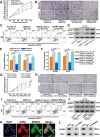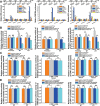CBFβ promotes colorectal cancer progression through transcriptionally activating OPN, FAM129A, and UPP1 in a RUNX2-dependent manner
- PMID: 34050318
- PMCID: PMC8563980
- DOI: 10.1038/s41418-021-00810-2
CBFβ promotes colorectal cancer progression through transcriptionally activating OPN, FAM129A, and UPP1 in a RUNX2-dependent manner
Abstract
Colorectal cancer (CRC) is commonly associated with aberrant transcription regulation, but characteristics of the dysregulated transcription factors in CRC pathogenesis remain to be elucidated. In the present study, core-binding factor β (CBFβ) is found to be significantly upregulated in human CRC tissues and correlates with poor survival rate of CRC patients. Mechanistically, CBFβ is found to promote CRC cell proliferation, migration, invasion, and inhibit cell apoptosis in a RUNX2-dependent way. Transcriptome studies reveal that CBFβ and RUNX2 form a transcriptional complex that activates gene expression of OPN, FAM129A, and UPP1. Furthermore, CBFβ significantly promotes CRC tumor growth and live metastasis in a mouse xenograft model and a mouse liver metastasis model. In addition, tumor-suppressive miR-143/145 are found to inhibit CBFβ expression by specifically targeting its 3'-UTR region. Consistently, an inverse correlation between miR-143/miR-145 and CBFβ expression levels is present in CRC patients. Taken together, this study uncovers a novel regulatory role of CBFβ-RUNX2 complex in the transcriptional activation of OPN, FAM129A, and UPP1 during CRC development, and may provide important insights into CRC pathogenesis.
© 2021. The Author(s), under exclusive licence to ADMC Associazione Differenziamento e Morte Cellulare.
Conflict of interest statement
The authors declare no competing interests.
Figures







Similar articles
-
Metastatic breast cancer cells inhibit osteoblast differentiation through the Runx2/CBFβ-dependent expression of the Wnt antagonist, sclerostin.Breast Cancer Res. 2011 Oct 27;13(5):R106. doi: 10.1186/bcr3048. Breast Cancer Res. 2011. PMID: 22032690 Free PMC article.
-
Impaired cell cycle regulation of the osteoblast-related heterodimeric transcription factor Runx2-Cbfbeta in osteosarcoma cells.J Cell Physiol. 2009 Dec;221(3):560-71. doi: 10.1002/jcp.21894. J Cell Physiol. 2009. PMID: 19739101 Free PMC article.
-
Cbfβ deletion in mice recapitulates cleidocranial dysplasia and reveals multiple functions of Cbfβ required for skeletal development.Proc Natl Acad Sci U S A. 2014 Jun 10;111(23):8482-7. doi: 10.1073/pnas.1310617111. Epub 2014 May 21. Proc Natl Acad Sci U S A. 2014. PMID: 24850862 Free PMC article.
-
Core Binding Factor-β Knockdown Alters Ovarian Gene Expression and Function in the Mouse.Mol Endocrinol. 2016 Jul;30(7):733-47. doi: 10.1210/me.2015-1312. Epub 2016 May 13. Mol Endocrinol. 2016. PMID: 27176614 Free PMC article.
-
The RUNX/CBFβ Complex in Breast Cancer: A Conundrum of Context.Cells. 2023 Feb 16;12(4):641. doi: 10.3390/cells12040641. Cells. 2023. PMID: 36831308 Free PMC article. Review.
Cited by
-
E3 Ubiquitination Ligase MYLIP Mediates the NKRF/SLC25A34 Axis to Suppress Malignant Progression in Colorectal Cancer.Dig Dis Sci. 2025 Feb;70(2):581-597. doi: 10.1007/s10620-024-08735-9. Epub 2024 Dec 11. Dig Dis Sci. 2025. PMID: 39661280
-
RUNX2 prompts triple negative breast cancer drug resistance through TGF-β pathway regulating breast cancer stem cells.Neoplasia. 2024 Feb;48:100967. doi: 10.1016/j.neo.2024.100967. Epub 2024 Jan 13. Neoplasia. 2024. PMID: 38219710 Free PMC article.
-
NIBAN1, Exploring its Roles in Cell Survival Under Stress Context.Front Cell Dev Biol. 2022 Apr 19;10:867003. doi: 10.3389/fcell.2022.867003. eCollection 2022. Front Cell Dev Biol. 2022. PMID: 35517496 Free PMC article. Review.
-
Multiple Roles of the RUNX Gene Family in Hepatocellular Carcinoma and Their Potential Clinical Implications.Cells. 2023 Sep 19;12(18):2303. doi: 10.3390/cells12182303. Cells. 2023. PMID: 37759525 Free PMC article. Review.
-
Multiple roles of LncRNA-BMNCR on cell proliferation and apoptosis by targeting miR-145/CBFB axis in BMECs.Vet Q. 2023 Dec;43(1):1-11. doi: 10.1080/01652176.2023.2262525. Epub 2023 Oct 9. Vet Q. 2023. PMID: 37807922 Free PMC article.
References
Publication types
MeSH terms
Substances
Grants and funding
- 31870821/National Natural Science Foundation of China (National Science Foundation of China)
- 31571458/National Natural Science Foundation of China (National Science Foundation of China)
- 31900458/National Natural Science Foundation of China (National Science Foundation of China)
- 81972267/National Natural Science Foundation of China (National Science Foundation of China)
- 31771550/National Natural Science Foundation of China (National Science Foundation of China)
LinkOut - more resources
Full Text Sources
Other Literature Sources
Medical
Molecular Biology Databases
Research Materials
Miscellaneous

